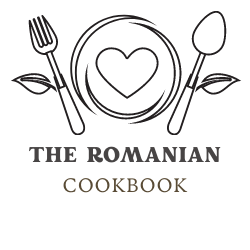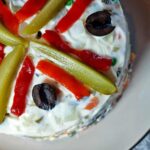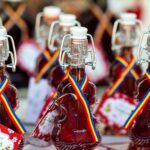Easter is one of the two major holidays in Romania, alongside Christmas. For Easter, Romanians come together around their families and celebrate with a feast that spreads on the entire day. Easter Sunday is the most important day of this Christian holiday when the traditional Easter meal takes place. Many of the traditional Easter dishes have roots in the Orthodox religion.
In this article, I want to tell you about the traditional Romanian Easter foods, as well as how the celebrations used to take place in my family, as I was growing up. Now, living abroad, I celebrate Easter on a much smaller scale, but I still make sure to cook the majority of the traditional Romanian Easter dishes that I used to love growing up.
The cooking for the Easter lunch usually starts on the Thursday before, when the red eggs are made. The Easter-painted eggs are very important and never miss from the table. The tradition says to make them on the Big Thursday, which is when Jesus died on the cross. It is believed that Mary brought a basket of eggs which she placed under the cross. As the blood of Jesus dripped from his body, it reached the eggs and coloured them red. There is a lot of symbolism behind this tradition as well. On Easter Sunday, we knock the eggs and say “Jesus has arisen” as the shell cracks – symbolising the opening of the grave, on the third day after his death on the cross.
Besides the red eggs, there are other several traditional dishes that never miss from the Easter table. The main meat that Romanians eat at Easter is lamb. It is actually quite difficult to find lamb for sale in other times of the year. Most people will buy either half or an entire lamb, depending on the size of the family. Growing up, it was not possible to buy less than that, therefore all the meat was used to make different dishes for the Easter table.
In my family, the Easter lunch would start at around 1 pm. The entire family would gather around a large, extended table taking most of the space in our living room, and would enjoy quality time together until the early hours of the evening. The food would come in turns, with the appetisers first, followed by the soup, meat dishes, and a selection of cakes at the end. The food would be accompanied by traditional Romanian drinks such as palica and wine, or juice for the children.
Romanian Easter Appetizers
The Easter celebration starts with the appetisers, which consist of a selection of cooked dishes, cold cuts, cheeses, as well as spring vegetables such as green onions, spring garlic and radishes. Tomatoes and cucumbers are also present on the table, sliced, as well as fresh bread. We don’t miss typical salads such as roast aubergines, mushroom and pickles salad, and even cod roe salad sometimes.
Red Eggs

As mentioned before, the red eggs are the most important element of the Romanian Easter dinner. We usually start the meal with the ritual of knocking the eggs. If your egg cracks, then you eat it. If it doesn’t, you have to turn it around and knock it with someone else at the table. It continues until everyone has cracked their eggs.
Making red eggs is very easy, with kits which are bought in the supermarkets. In the countryside, locals are still making red eggs using traditional ways, such as boiling them with red onion leaves and putting them in stockings alongside leaves, to create beautiful patterns on them.
Click here to see how to make Romanian painted eggs.
Drob

The drob is a humble dish made from the organs of the lamb. As mentioned earlier, for Easter, families usually buy an entire lamb, which comes with all its organs. In the Romanian tradition, we appreciate the sacrifice of the lamb, and we don’t throw away anything from the animal. The organs are cooked alongside spring greens, herbs and whole-boiled eggs into a meatloaf. It is served sliced, as an appetiser, on the Easter table. I like it with extra spring fresh onions, and a touch of mustard on top.
Click here to see my recipe for the Romanian drob.
Deviled Eggs

More eggs? Yes! Easter is all about the eggs, even though as I grew up, my mom stopped making this recipe for this day. Instead, she used to re-use the already boiled, red eggs, to make deviled eggs a few days later, once we got bored of the classic ones.
I was always excited to eat deviled eggs, as they were not that common in my household. I love the creamy yolk mixed with mayo and sometimes, pate. It is such a simple recipe that packs so much flavour.
Click here to see my recipe for Romanian deviled eggs.
Boeuf Salad

Boeuf salad is never missed from any celebratory meal in Romania, so you can expect to find it among the Easter appetisers. Even though it’s a variation of the classic Olivier salad, the boeuf salad is so imprinted in Romanian cuisine that we consider it one of our national dishes. The combination of soft-boiled potatoes and carrots with the crunch of the pickles and the sweetness of the mayonnaise is just divine.
Click here to see my Romanian Boeuf Salad Recipe.
Romanian Easter Mains
If you are wondering why the Romanian Easter Lunch takes the entire day, it’s because we have several main courses, most of them lamb-based. We start with the lamb soup, followed by either the oven-baked lamb steak or the Romanian lamb stew. Sarmale, the national dish of Romania, never misses either.
Lamb Soup

Lamb soup is one of my favourite Easter dishes. I always looked forward to it as my mom and later on, my grandma, would only make it once a year. The soup is usually made with the head and bones of the lamb, and soured with fresh sorrel. It is then dressed with sour cream and egg yolks and served with a handful of lovage leaves.
This is one of my favourite Romanian soups and I always make it for Easter. Even though I am living abroad and can’t find fresh sorrel here, I still enjoy lamb soup as much as I did when I was a child. My mom used to prepare it for me one day ahead, so I could quench my craving and not fill my stomach with soup on Easter day.
Click here to see my Romanian Easter lamb soup recipe.
Oven Baked Lamb Steak

The lamb steak is the star of the Easter dinner table. It consists of an entire leg of lamb (usually the back leg) slow-cooked in the oven for hours, in white wine, garlic, and thyme. It’s so tender that it melts in your mouth. We usually serve it with mashed potatoes and a lot of that herby, aromatic sauce on top.
Click here to see my roast leg of lamb recipe.
Stufat de Miel – Lamb Stew
Another great recipe to serve for Easter is the lamb stew. This dish is extremely rich and fragrant, and it is made with the back of the lamb. The stew requires pieces of lamb with bone, spring garlic, green onions, red wine, good quality tomato passata and lamb stock. The spring garlic gives this dish such an incredible depth of flavour.
Sarmale

Sarmale is the national dish of Romania. We eat them at any big celebrations such as Christmas, Easter, weddings, christenings, funerals or wakes. These humble cabbage rolls stuffed with a mix of pork and veal minced meat are part of our identity. They are served with polenta, sour cream, and pickled green chilli peppers.
Click here to see my mom’s sarmale recipe.
Romanian Easter Desserts
When it comes to dessert, for Easter, we usually serve a selection of different ones. The main one is the “Pasca”, which is like a baked cheesecake encrusted in a sweet dough. Because we also serve cozonac, I prefer to make the pasca without the extra dough, for a lighter alternative. Besides these two main desserts, we would usually have a selection of smaller cakes as well, such as the layered lemon cake, the poppyseed and vanilla slice, or the walnut and vanilla cake.
Pasca

Like many Easter traditions in Romania, Pasca finds its roots in religion. In villages, it is made on the Saturday before Easter and taken to the church, where it is arranged alongside the iconic red eggs, awaiting the priest’s blessing during the Easter Vigil.
The classic Pasca recipe involves using dough similar to that of cozonac, filled with a mixture of cottage cheese, eggs, honey, and occasionally raisins. Topping off the Pasca is a cross-shaped ornament crafted from the same dough, symbolizing the religious significance of the Easter season. However, in the cities, we usually make it a bit differently, to speed up the process by removing the dough element.
The taste of the Pasca is delicious and I am always looking forward to making it for Easter. I actually discovered the Pasca quite late in life, as when I was a child, my mom didn’t use to make it. She tried it one year when I was a teen, and since then it has never missed from our Easter dinner table.
Click here to see my Romanian Pasca recipe.
Cozonac

Cozonac is the traditional dessert of Romania. It consists of a sweet bread filled with cocoa, walnuts, raisins, and Turkish delight. More modern takes see it filled with almond cream or even Nutella. I am a fan of the classic version though. Whilst it does take a while to make, it’s very well worth the effort.
Click here to see my Romanian cozonac recipe.
For more similar articles, check out my recommendations below:
Like it? Pin it!





